04 Library
Shape
It is used for storing bitmaps. The source of bitmaps are: system bitmap library and imported bitmaps.


You could view all the bitmaps in the library, and import or export them according to your own needs. You can also create multi-state bitmaps.
There are four kinds of galleries as follows.
- Project gallery: The bitmaps added to the project and the bitmaps applied to the project are displayed in the project gallery.
- Rename: You could click one bitmap to rename. Bitmap names can be a combination of Chinese characters, numbers, and letters (case sensitive), but no special characters. The length of it cannot exceed 18 characters.
- When you place the mouse on the display area of bitmap, its name and resolution would be displayed.
- You can export the current project bitmap file, import the file in another project, and call it in the new project.
- System gallery: The software system gallery, including pictures and vector diagrams (svg picture).
- Gallery file: You can import the corresponding picture file from and call it in the project library.
- You could import library files with suffixes "aa. pLb" and "aa. bLb".
- Select one bitmap, right click to perform three operations: Use library, Delete library, and rename library (F2).
- Extended gallery: The image applied in the screen style can be found in the extended gallery.
Font
User can pre-set the font and directly call the settings in the font library when editing the project.


| Items | Description |
|---|---|
| Add font | Add an new font in library |
| Delete font | Delete selected font |
| Properties | Edit selected font |
| Close | Close current setting window |
| Help | Click it to open help document |
Operating procedures of create font

- Click [Add font] to open setting window.
- Enter font name.
- Select font.
- Select font size.
- Select font style.
- Preview font.
Text
Text library contains commonly used text. It avoids setting the text repeatedly. HMI provides up to 8 languages in text library.
Click "Project"→"Text" to open the setting window.


| Items | Description |
|---|---|
| ID | The identifier of the text in the list |
| Languages | One text can be set in 8 languages |
| New | Add an new text in list |
| Delete | Delete selected text |
| Edit | Edit select text |
| Close | Close text library list |
| Help | Open help document |
| Export EXCEL | Export text library to PC as excel file |
| Import EXCEL | Import text library from excel file |
| Clear | Delete all texts in list |
Operating procedures of creating new text
- Click "New" button to open setting windows as below.
- Set at least one language and support up to 8 languages.
- Click "Save" to complete operations.

Email setting
In "PIStudio" software, click "Project" → "E-mail" to open email function setting screen.
Introduction
Wecon HMI can send email with information from fields to the specified email address as soon as the conditions are triggered, but email sending is based on the network.

SMTP Settings
- Sender Name: Fill the sender's name, which is composed of Chinese characters, letters (case sensitive) and numbers. But it can not contain the following special English symbols: ',', ';', '"', '<'. Maximum character length 32 is allowed.
- Password: Fill in the password or authorization code of the mailbox. If the server needs to set the authorization code, the authorization code needs to be used. If the authorization code is not used, the password is used. Please refer to the SMTP service in the mailbox for the authorization code information. It cases sensitive, maximum character length 32 allowed in password.
- Confirm Password: Confirm the password or authorization code of the mailbox.
- Email Address: Fill in the sender's email address, case sensitive, maximum character length 32 allowed in it.Such as support@we-con.com.cn.
- SMTP Server: Please refer to the mailbox account settings. If you enter a common mailbox, the corresponding server address will be automatically written. such as smtp.exmail.qq.com.
| Email server | Port number | |
|---|---|---|
| 163 email | smtp.163.com | 465 |
| 126 email | smtp.126.com | 465 |
| QQ email | smtp.qq.com | 465 |
| Sina email | smtp.sina.com | 465 |
| Sohu email | smtp.sohu.com | 465 |
| Yahoo email | smtp.mail.yahoo.com.cn | 465 |
| Google email | smtp.gmail.com | 465 |
- Encryption Type: SSL is a security protocol that provides security and data integrity for network communications. It encrypts network connections at the transport layer; TLS (STARTTLS) upgrades connections to SSL instead of using a separate encrypted communication port.
- The Port Number: Enter corresponding port number according to the SMTP serve addrress entered. You could only enter interger between 1 and 65535. Do not enter more than 6 digits in length. Common port numbers are port 25, 465 and 587.
- Port 25: It does not protect the original data when transmitting data. The data can be seen. Generally, port 25 must be selected as no encryption or TLS(STARTTLS) encryption mode to send data correctly.
- Port 465: It protect the original data when transmitting data. The data can not be seen. Generally, port 465 must be selected as SSL encryption mode to send data correctly.
- Port 587: The original data is protected only after the TLS(STARTTLS) command is executed. Generally, port 587 must be selected as TLS(STARTTLS) encryption mode to send data correctly.
- Error Message
- Set the error message receiving address, you could use the information to get the reasons of errors.
- The error types in the mail function are divided into two types: custom rule error and server's error.
- Custom rule errors are as follows.
| Message |
|---|
| Email settings are incorrect |
| Email account is incorrect |
| Email password could not include blank |
| the settings of SMTP server are incorrect |
| The range of SMTP server ports number should be integer, which is between 1 and 65535. |
| The type of encryption for SMTP is incorrect |
| The name of sender or email address setting is incorrect. |
| The names of Recipients or email address setting are incorrect. |
| The names of CC recipients or email address setting are incorrect. |
| The names of Secret delivery recipients or email address setting are incorrect. |
| Email topic could not be blank |
| Email content could not be blank |
| Total size of attachments should be below 25M |
| Attachment "xxxx" is nonexistent |
Server's errors are as follows.
| Message |
|---|
| smtp-server: 554 DT: SPM |
| smtp-server: 550 RP: TRC |
| smtp-server: 550 Limitation of connecting counts |
| smtp-server: 535 |
| smtp-server: 550 Error: Content rejected |
| smtp-server: 451 Internal server error |
| smtp-server: 535 Invalid login user or password |
| smtp-server: 550 too many sending requests today |
| smtp-server: 452 Too many recipients received this hour. |
| smtp-server: 535 Error: Authentication failed, system busy |
| could not connect: Connection timed out |
| Unexpected EOF on SMTP connection |
| could not initiate SSL/TLS connection |
| smtp-server: 530 Need to issue a STARTTLS command first. |
| could not resolve host |
| could not connect: Connection timed out |
| could not connect: Connection refused |
| smtp-server: 550 User not found: aaa.163.com |
- Manual Trigger
It is for modifying the email-sending settings when HMI is running. According to the set manual trigger address, the address is offset backward to get the address of the corresponding function (a total of 201 words). Take HDW100 as an example.
| Address | Description |
|---|---|
| HDX100.0 | Sending trigger |
| HDX101.0 to HDX101.15 | It is used for triggering recipient groups, for example, HDW101.0 is set ON, and the address in group 1 will be in recipient list. |
| HDX103.0 to HDX103.15 | It is used for triggering recipient groups, for example, HDW103.0 set ON, and the address in group 1 will be in CC list. |
| HDX105.0 to HDX105.15 | It is used for triggering recipient groups, for example, HDW105.0 set ON, and the address in group 1 will be in BCC list (Secret delivery). |
| HDW107 to HDW171 | The subject length is limited to 64 words. (If it exceeds, it will intercept 64 words of content) |
| HDW172 to HDW300 | The content length is limited to 128 words. (If it exceeds, it will intercept 128 words of content) |
| HDX301.0 | Whether to send an alarm record attachment (a file named AlarmDataFile.db) |
- Emails that sent manually are not queued. Emails triggered by bit change, rising edge, falling edge and timing need to be sent in the sequence of triggering. The maximum value is 100, and those who are added after it is exceeded will be discarded. If an email is sending, it would send immediately after the current email is sent. If there is no email sending, it would send immediately.
- If the trigger condition sent manually is the rising edge trigger, before the mail is sent, no new mail will be sent even if it is triggered again. No matter the email is sent successfully or not, the corresponding trigger would be OFF.
- Emails that sent manually would only be sent once no matter whether ending error is custom error, network or other errors.
Email sending settings

- Add. A maximum of 1024 email can be added.
- Modify. Select an email to modify the content and configuration.
- Delete. You could select an email to delete or click the "ID" column to delete in batch.

Email sending configuration.
- Theme. The value cannot be empty and case sensitive. The total length cannot exceed 256 characters.
- Content of email. The contents are divided into three combinations: text, alarm and variable. The list can contain only 32 items at most, and the total length of the preview cannot exceed 1024 items.
- Text. You could directly edit the text of language 1 to language 3. If you need to set multiple languages, click "edit all text" to set. You may also select "Text library". The content is case sensitive, and the total length of English/Chinese characters/numbers/symbols does not exceed 253.
- Alarm. You could select "bit alarm" or "word alarm" from the list. The content is from alarm text. if the alarm changes, the content changes with it. The content is case sensitive, and the total length of English/Chinese characters/numbers/symbols does not exceed 253.
- Variable. Set the corresponding variable address. Read value or strings according to the specified format, and the read information will be displayed in the corresponding position in the mail content.
- Preview. Combine the content of current edited email and display it for you to modify the content conveniently. The preview length cannot exceed 1024.
- Sending method. It is divided into timed send interval and bit address trigger transmission. The two methods cannot be used at the same time.
- Timed send interval. After booting, the current system time is used to start calculating, and each time the time is up, the information will be sent to the set recipient in the form of an email, and the minimum time should be set to 5 minutes. Note: The first boot is not sent.
- Bit address trigger tranmission. When the set trigger address meets the trigger conditon, the information will be sent to the set recipient in the form of an email. If the content select alarm, the alarm address would be written in the trigger address. There are three methods to trigger: sending on rising edge, sending on falling edge and send when the bit changes.
- Recipient. It is set in groups. You could send multiple groups, and each group can have multiple recipients.
- Add CC. Sends the current email to other recipients.
- Add secret delivery. Sends the current email to other recipients, but the recipient and cc recipients do not see the BCC recipient.
- when sending an email, you must set a recipient. CC recipients and BCC recipients are not to be set. The total number of recipinet, CC recipients and BCC recipients is 40.
- Recipient priority. Set the priority order of recipients to recipient, BCC, and CC.
Recipient group setting

- All Group. The groups you added.
- Group to send. The groups that you send the emails to.
- Open recipient settings. Set the information of recipients, and add and subtract groups.
Recipient setting

- Add. Add a recipient. There are non-dynamic recipient and dynamic recipient. They cannot be used at the same time. You may just fill in the recipient's name and email address. The dynamic recipient address is limited to 32 characters, and a maximum of 40 recipients can be added.

- Modify. Select one recipient and click "modify" or double click the recipient to modify. If it is non-dynamic recipient, you could modify the name and email address. The email is unique. If it is dynamic recipient, you could modify the address, and the address is unique.
- Delete. Select one recipient or multiple recipients to delete, or click the ID column to select all.
- Number of group. You could click the up/down arrow to increase or decrease groups. The default number is 1. The maximum number is 16.
- Description. To describe the group information. The total length shall not exceed 32.
Test sending settings

| Error code | Cause of reason |
|---|---|
| 0 | CSMTP_NO_ERROR |
| 100 | WSA_STARTUP = Unable to initialize winsock2 |
| 101 | WSA_VER = Wrong version of the winsock2 |
| 102 | WSA_SEND = Function send() failed |
| 103 | WSA_RECV = Function recv() failed |
| 104 | WSA_CONNECT = Function connect failed |
| 105 | WSA_GETHOSTBY_NAME_ADDR = Unable to determine remote server |
| 106 | WSA_INVALID_SOCKET = Invalid winsock2 socket |
| 107 | WSA_HOSTNAME = Function hostname() failed |
| 108 | WSA_IOCTLSOCKET = Function ioctlsocket() failed |
| 109 | WSA_SELECT |
| 110 | BAD_IPV4_ADDR = Improper IPv4 address |
| 200 | UNDEF_MSG_HEADER = Undefined message header |
| 201 | UNDEF_MAIL_FROM = Undefined mail sender |
| 202 | UNDEF_SUBJECT = Undefined message subject |
| 203 | UNDEF_RECIPIENTS = Undefined recipient |
| 204 | UNDEF_RECIPIENT_MAIL = Undefined mail recipient |
| 205 | UNDEF_LOGIN = Undefined user login |
| 206 | UNDEF_PASSWORD = Undefined user password |
| 207 | BAD_LOGIN_PASSWORD = Invalid user login or password |
| 208 | BAD_DIGEST_RESPONSE = Server returned a bad digest MD5 response |
| 209 | BAD_SERVER_NAME = Unable to determine server name for digest MD5 response |
| 300 | COMMAND_MAIL_FROM = Server returned error after sending MAIL FROM |
| 301 | COMMAND_EHLO = Server returned error after sending EHLO |
| 302 | COMMAND_AUTH_PLAIN = Server returned error after sending AUTH PLAIN |
| 303 | COMMAND_AUTH_LOGIN = Server returned error after sending AUTH LOGIN |
| 304 | COMMAND_AUTH_CRAMMD5 = Server returned error after sending AUTH CRAM-MD5 |
| 305 | COMMAND_AUTH_DIGESTMD5 = Server returned error after sending AUTH DIGEST-MD5 |
| 306 | COMMAND_DIGESTMD5 = Server returned error after sending MD5 DIGEST |
| 307 | COMMAND_DATA = Server returned error after sending DATA |
| 308 | COMMAND_QUIT = Server returned error after sending QUIT |
| 309 | COMMAND_RCPT_TO = Server returned error after sending RCPT TO |
| 310 | MSG_BODY_ERROR = Error in message body |
| 400 | CONNECTION_CLOSED = Server has closed the connection |
| 401 | SERVER_NOT_READY = Server is not ready |
| 402 | SERVER_NOT_RESPONDING = Server not responding |
| 403 | SELECT_TIMEOUT |
| 404 | FILE_NOT_EXIST = File not exist |
| 405 | MSG_TOO_BIG = Message is too big |
| 406 | BAD_LOGIN_PASS = Bad login or password |
| 407 | UNDEF_XYZ_RESPONSE = Undefined xyz SMTP response |
| 408 | LACK_OF_MEMORY = Lack of memory |
| 409 | TIME_ERROR = time() error |
| 410 | RECVBUF_IS_EMPTY = RecvBuf is empty |
| 411 | SENDBUF_IS_EMPTY = SendBuf is empty |
| 412 | OUT_OF_MSG_RANGE = Specified line number is out of message size |
| 413 | COMMAND_EHLO_STARTTLS = Server returned error after sending STARTTLS |
| 414 | SSL_PROBLEM = SSL problem |
| 415 | SSL_PROBLEM = SSL problem |
| 416 | STARTTLS_NOT_SUPPORTED = The STARTTLS command is not supported by the server |
| 417 | LOGIN_NOT_SUPPORTED = AUTH LOGIN is not supported by the server |
Email status
Network disconnection error
If the fault is determined as a network disconnection error, the system does not delete the sent information and does not record the number of errors, and it would make an infinite send attempt.
Custom rule error
If the fault is determined as a custom rule error, delete the information.
Server return error
If the fault is determined as a server return error, then the error time add 1. It would try to send the email for 3 times. Regardless of whether the transmission is successful or not, it would delete the email to be sent. The test results are as follows.
| Server name | The number of sent | Consequences of exceeding the limit |
|---|---|---|
| 126 | 160 | No more delivery on that day |
| 163 | 160 | No more delivery on that day |
| we-con | 800 | No more delivery on that day |
| 50 | It can be sent again after a few minutes or a few hours | |
| sohu | 160 | No more delivery on that day |
| sina | 50 | It can be sent again after a few minutes or a few hours, but cannont be received normally |
| gmail | 500 | No more delivery on that day |
Message Prompt
- If the email to be sent is deleted, a message will pop up.
- If the email is sent successfully, a messge will pop up: "The email is sent successfully."
- If the five symbols ',' , ' | ', '<', '>' and '&' appear in the fields set by the message prompt, the message prompt will display an abnormal message.
Mail attachment
Currently, the email attachment function only supports sending the specified alarm record (AlarmDataFile.db file), and does not support selecting content to send.
Address
Address library contains commonly used addresses. It not only avoids setting the addresses repeatedly but also expresses the function of an address more clearly.
Click "Project"→"Address" to open the setting window.


| Item | Description |
|---|---|
| Word Address | Select [Word Address] to display word addresses in list |
| Bit Address | Select [Bit Address] to display bit addresses in list |
| Add | Add a set of address to display in the address library to associate addresses with identifiers |
| Insert | Insert (add) an new address before selected item in list |
| Edit | Edit selected item |
| Delete | Delete selected item in list |
| Up | Move the selected item up one line |
| Close | Close current setting window |
| Export EXCEL | Export address library to PC as excel file |
| Import EXCEL | Import address library from excel file |
| Clear | Delete all items in list |
| Down | Move the selected item down one line; |
| Help | Click it to open help document; |
Operating procedures for creating a new address

- Click "Add" to open address edit window.
- Set "Address name".
- Set address.
- Set PLC station number (It is not necessary setting, the user sets it according to the actual situation).
Mapping
Address mapping is to build the relationship between two different addresses. Forwarding address from source address to target address, so the value in both addresses would be same according to the predefined mapping mode. Both addresses could be from different, in this way, to make HMI processing faster.
For example: Forward "D0" to "HDW100" (length: 10), so the address D0, D1,..., D9 would be related to HDW100, HDW101, .., HDW109.
Description

Address type
It is used for selecting address type in address mapping.
Source address
The origin address needs to be mapped to other addresses. If there is calculation, 2 source addresses are required, and the result would be saved in "target address".
Data type: Only word address need to set data type. If it is the address of 32-bit register, check "32-bit register".
Calculation
Designated mathematical relationship between two source addresses, the result will be saved in target address.
Length
It is used to set the length of the operation address.
For example
Source address is D0, target address is 40, and length is 10.
Result
- 40=D0
- 41=D1
- ...
- 48=D8
- 49=D8
Mode
It provides two modes, Read-write and read only. The value of source address would not change if target value changed after read only selected.
Update frequency
It provides two modes, general and read-through.
- General: Read data from HMI cache (Recommended)
- Read-Through: Read data directly from the device without going through the HMI cache
Mapping
This is the control bit for mapping one item, the default mode is mapping when OFF; If user wants to change the control condition, please check [Mapping when ON];
Target address
It is address used to store source address data;
Cont. Write:
Write address length for a single time, used for some special device addresses that need to be written continuously;
Global mapping control
The function and mode are similar to [Mapping], but it is used to control all mapping items. Global mapping can only be enabled when the global control address is set to 0. The entire instruction set will not be enabled when the address is set to 1. If "Control Enabled when ON" is checked, the opposite will happen. When the address is set to 1, mapping is enabled, and when it is set to 0, mapping is disabled. The setting screen below show;

Buttons
- Clear: Delete all settings in settings, such as [Source address], [Length], and so on.
- Add: Create a new mapping item.
- Edit: Change selected item.
- Delete: Delete selected item.
- Clear list: Delete all mapping items in list.
- Close: Close address mapping window.
- Help: Click it to open help document.
Item List
It lists all address mapping items.
Function description
Address mapping is to map the source address to the destination address or the two source addresses are mapped to the destination address by some operation. The source and destination addresses can be PLC addresses or internal addresses or from different serial ports.
For example Map D0 to HDW100, the map length is 10, then the value of D0 to D9 are mapped to HDW100 to HDW109.
There are two map methods: read and write and read-only.
- Read and write: If the value of source address is changed, the value of the destination address changes accordingly. After the value of the destination address is changed, the value of the corresponding source address does not change. Four some four operations or logical operations, they can only be selected in this way.
- Read-only: If the value of the source address is changed, the value of the destination address changes accordingly. After the value of the destination address is changed, the value of the corresponding source address changes too. Four some four operations or logical operations, they can not be selected in this way.
There can be two sets of source addresses, and mapping the results to the destination address through operations (four operations or logical operations). For example, source address 1 is HDW100, source address 2 is HDW200, Map to destination address HDW300 by addition and the map length is 10.
- HDW300=HDW100+HDW200
- HDW301=HDW101+HDW201
- HDW309=HDW109+HDW209
The user could use the bit address to control whether to enable the mapping function. There is one-bit address for bits and one for words. Each mapping block also has a bit address. Bit address mapping and word address mapping, there are controlled by their own global bit addresses. Each mapping block relationship can also have its own control address, but the global control bit address has a high priority.
String table
A collection entered by the user in advance, contents of table can be referenced by text object. The string table support eight languages at max.
Click on the String table in "Library" on the upper left corner of the software, as shown in the following figure:


String table size:
① i series, ie series, 3000ig series, General series 3000: The total number of text cannot exceed 8000, or the total size of all string tables does not exceed 1M.
② General series 8000, General series 9000 and 8000ig series: The total number of texts cannot exceed 10000, or the total size of all string tables does not exceed 5M.
Sound library
TTS voice broadcast converts text into voice and plays it back. In HMI, TTS voice broadcast can be used to prompt users to perform operations, display information, and other applications.
Model restrictions: 8000ig, RH series
Sound files can be added in the sound library, generate sound files, and set the system sounds of the HMI.
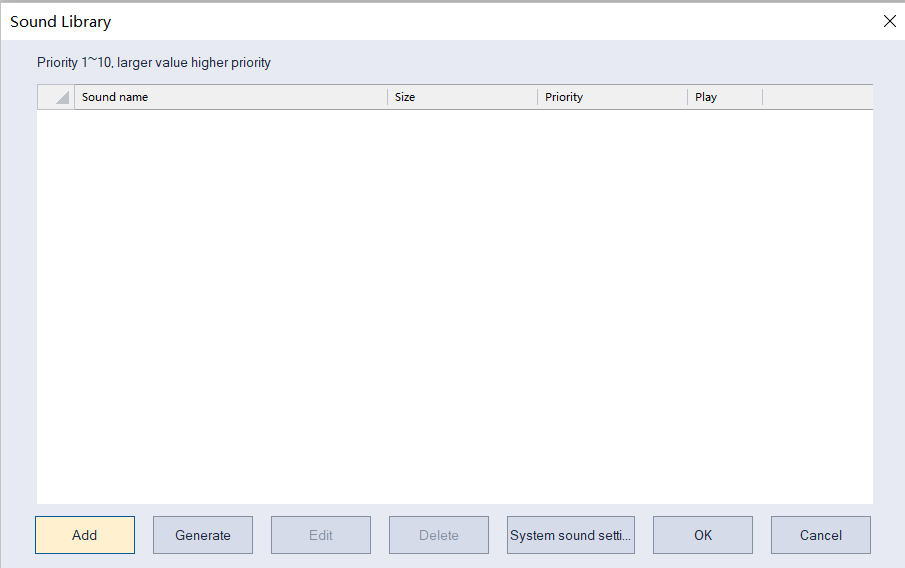
Adding a Sound File
1.Add a sound file to the sound library. WAV or MP3 formats can be added.
2.Sound File also can be added from a UDisk or SD card. Once added, insert the UDisk or SD card into HMI, and the sound file will appear in the sound library and play.

Generate sound file
1. In Sound Library, click the Generate. In the text of the pop-up screen, type the text to be converted into voice.
2. The sound source uses local synthesis and does not require an internet connection.
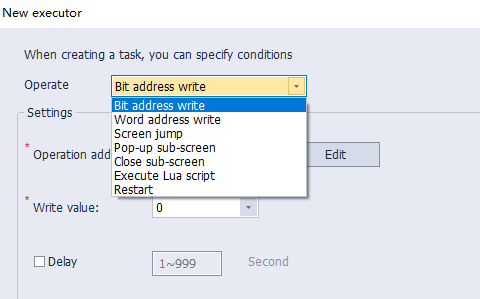
Voice Announcement Settings
Select bit switch, Enable Sound and select Sound in Security.
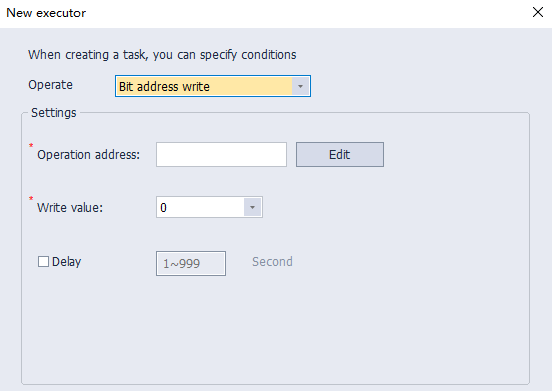
TTS function
Schedule
The schedule function allows the HMI to execute pre-scheduled tasks at specified times or according to specified conditions.
Compatible models: ig series, RH series
The scheduling function supports setting up to 128 scheduled tasks, each with 8 triggers and 8 execution tasks.
Project configuration → Library→ Schedule.
Click "New schedule" to create task.

Trigger

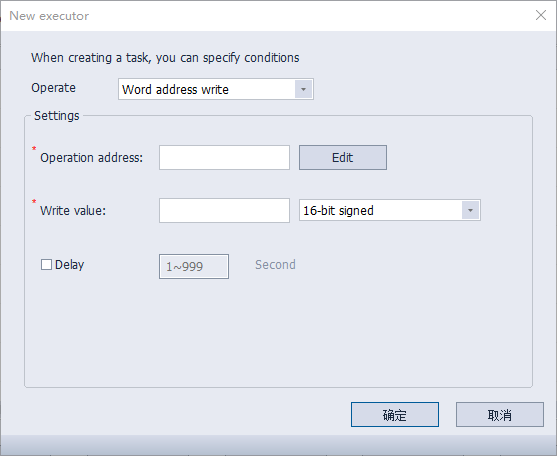
There are six different Start task
AS Scheduled: Schedules are divided into four different modes: Once, Every day, Every week and Every month.
- Once: This mode executes only once, triggered only when the start time arrives.
- Every day: The trigger will be triggered at the same time every day after the start time, and the trigger interval can be set.
- Every week: It will be triggered on the set date every week after the start time, and the number of weeks for the interval trigger can be set.
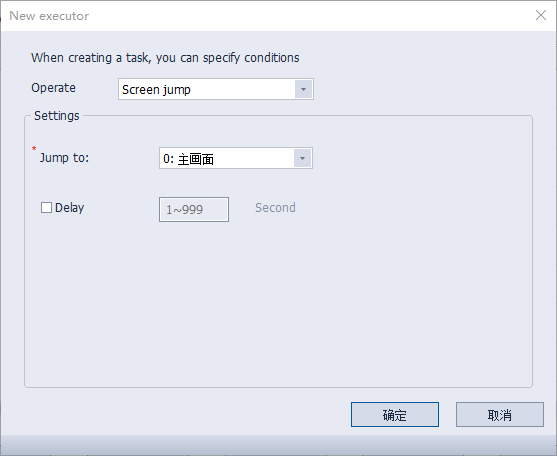
- Every month: In the monthly mode, there are two modes:
- By day mode: In this mode, after the start time, the day of the month can be set to trigger, and you can select multiple months and days.
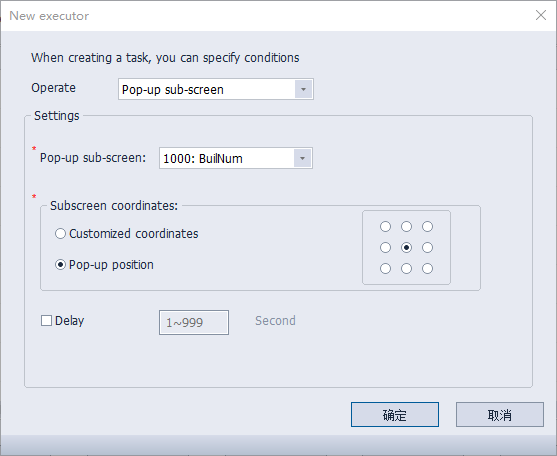
- Weekly mode: In this mode, after the start time, the day of the week can be set in the month to trigger. Both the number of weeks and the day of the week can be multiple selected.
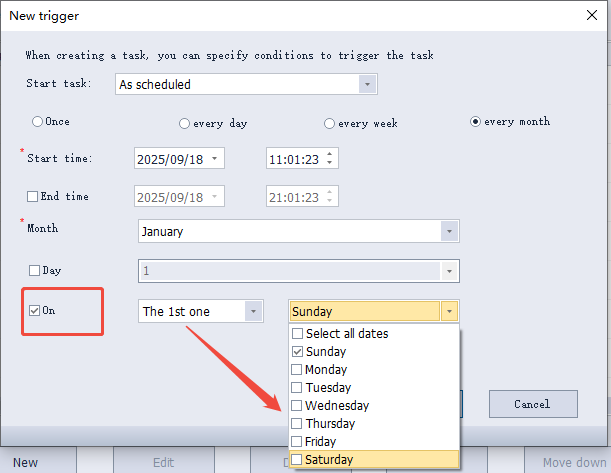
Bit address value changes: Set the bit address value to trigger from ON->OFF or from OFF->ON
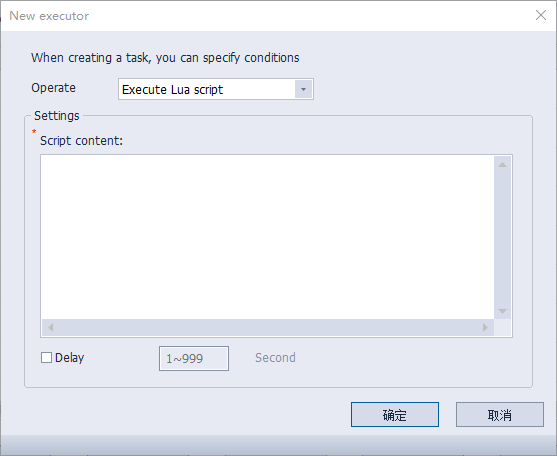
Word address value changes: Set the word address value to meet the set conditions (greater than, equal to, or less than a certain value) to trigger

On the specified screen: Jump to the specified screen trigger.
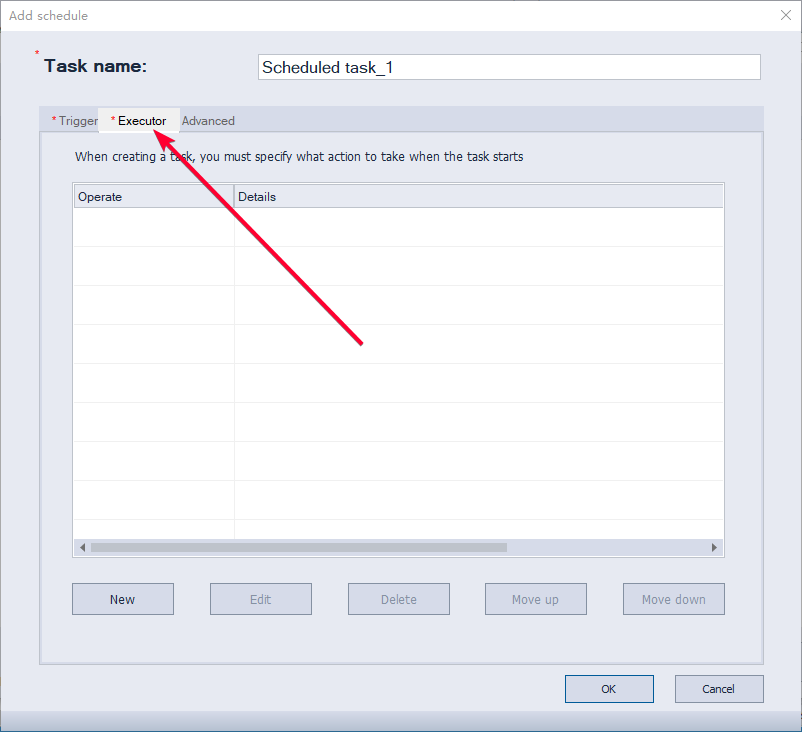
Successful upload to Cloud: Triggered when the device successfully or fails to access the cloud. If set to "fail to access the cloud", if the device has not accessed the cloud after a period of time (about 2 minutes) after startup, it will be judged as a cloud access failure.
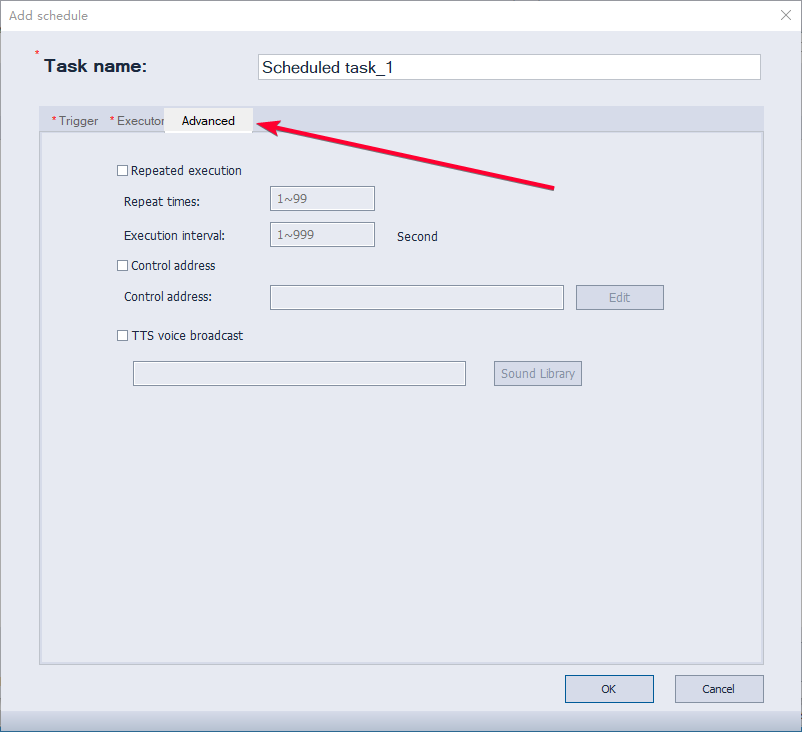
When the specified user logs in: Set to be triggered after a user successfully logs in.
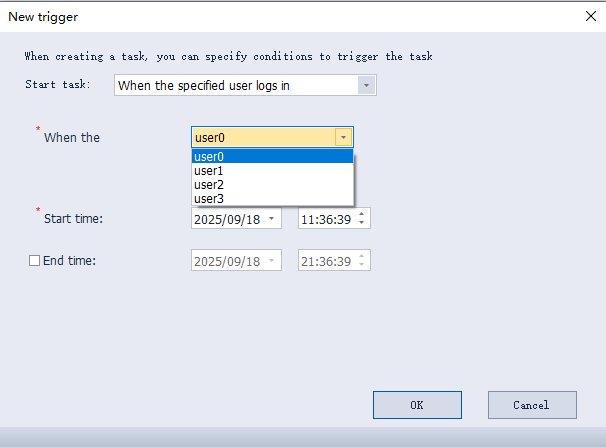
Executor
Select the executor. This interface can adjust the execution order of the executor.

Click "New" to pop up the interface where the operation is selected to perform. There are seven optional operations.

- Bit address write: 0 or 1 can be written to a certain bit address.

- Word address write: Write data of a specified data format to a word address.

- Screen jump: Jump to the specified screen.

- Pop-up sub-screen: The specified sub-screen can be popped up, the coordinates of the sub-screen pop-up can be customized, and the position of the sub-screen pop-up in the HMI grid can also be set.

- Close sub-screen: Closes an opened sub-screen.

- Execute Lua script: Writing a Lua script will execute the Lua script content, but one executor only supports writing one Lua script.

- Restart: Restart HMI.

Advance

- Repeated execution
- Repeat time: Specifies the number of times the executor executes after the trigger is triggered. The default value is one.
- Repeat Interval: Specifies the interval between repetitions. The default value is one second.
- Control address: This bit address controls whether the entire scheduled task is started.
- TTS voice broadcast: Specifies whether to play a voice prompt when the executor executes.
